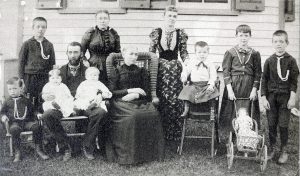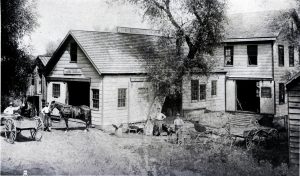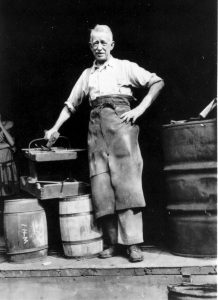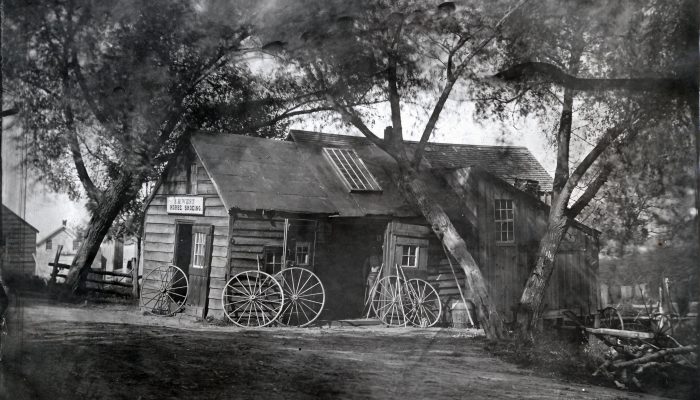History Close at Hand: Samuel West, Setauket blacksmith
By Beverly C. Tyler
The first of the West family line to come to the Three Village area were Mary Morris West and her two sons Kendall (known as Harvey) and Ebenezer. In 1836 Mary’s husband, Ebenezer West, died in Delaware. The 1850 census lists a Mary M. West, of the right age and birthplace, living in Connecticut with another family, suggesting she may have moved there from Delaware. By 1860, the West family bought a house on Old Town Road. Mary and Harvey were living there along with his wife, Mary Eliza Terrell, whose family lived just south at Walnut Tree Farm, and three children, including Samuel.

Carrie West, wife of Clinton West, noted that her father-in-law Samuel, born on April 8, 1953 in East Setauket, went to Bay Shore to learn the blacksmithing trade of George Thorne. Here, Samuel boarded with the Thornes and spoke of them as a fine family. In 1875, he bought the old Elbert Wheeler blacksmith shop that had earlier belonged to blacksmith William Smith, who owned the house on the corner of Main St. and Gnarled Hollow Road.
As told by Clinton’s son, Forrest West, “In April of 1881, West had a new shop built on the same site as his first and eventually added a two-story building next door where carriages were repaired.”
Carrie West noted, “Houses were built up to West’s blacksmith shop. Samuel West was a thorough high-class mechanic, a hard worker, a man of integrity, a devout Christian, a worker for temperance, devoted to his family and home. He had an extensive horse-shoeing trade where he shod the numerous running horses for the Vinguts, farm horses and many carriage horses for Strongs, Tinkers, Rebouls and many other well-known families from Miller Place to Smithtown. He was a clever ironworker; he did the carriage and wagon repair work for the community. He was a wagon maker and built farm wagons, light delivery wagons, and butcher wagons and sleds. He enjoyed hunting and he and Mr. Selah B Strong with their bird dogs enjoyed hunting together. They were great friends. Special horses were brought from a distance, because of his ability in handling them. His shop was a well-equipped, light shop, always very neat, and it has been said by his customers he was always so gentlemanly and courteous.”

In 1879, Samuel married Ida Augusta Hulse. Together they kept house in a rented home on Station Road, now named Gnarled Hollow Road. Here, five of their children were born. In 1889, he built a spacious two-story house on the corner of Main St. (now 25A) and Bayview Ave, where five more children were born, the first being twins. A great tragedy came to this happy family when Ida Augusta died in 1899 at the birth of the tenth child.
Samuel’s only sister, Mary Emmaline Loper (Mrs Gilbert E. Loper Sr.) of Port Jefferson, took his tenth baby into her home and tenderly brought her up with their children. Although crushed in heart, Samuel, a faithful father, brought his large family up in a splendid useful manner, each helping the other. He lived to enjoy four generations. (Based on Carrie West’s notes).
West used the 1881 shop until the 1930s, practicing as one of two East Setauket blacksmiths (Henry Rakow, the other smith, operated a shop on Shore Road.) West’s shop moved in 1951 to become a part of what is now the Long Island Museum of American Art, History and Carriages in Stony Brook. The shop still can be seen with most of the equipment used by West to make and repair the metal parts of wagon wheels, shoe horses, and fashion various items that were essential to the community.

As detailed in the “Island News” on August 15, 1932, “Three years and six months before entering the blacksmith trade, Mr. West went to sea with his father, who was by trade a spar maker. This October will end the 57th year he has been open for business on the same spot…One man in Miller Place calls in his car to take the smithy to his horse. He now charges $3 a head but [the Miller Place man] pays three and a half times as much for shoes. Mr. West says that when he first raised his price one customer sold his horses rather than pay it.”
It is difficult now to understand how important the blacksmith was to this community from the first settlement through the early twentieth century. The blacksmith was vital to the early farm family as he was an artisan, performing a trade in which few men had the ability to do themselves. Working mostly with iron, he produced hand-cut nails; farm tools, such as axes and hoes; cooking utensils, such as pot hooks, toasters and dippers; and hardware for houses and barns, including hinges and door bolts. He was also a farrier, shoeing horses and oxen. The blacksmith took a great deal of pride in his work as evidenced by the fine ornamental iron pieces that exist as candle holders, gates and other decorative accents. Many blacksmiths also provided various related or unrelated services for the community, such as pulling teeth for local residents and treating horses for minor ailments. These services were quickly abandoned when a doctor or a veterinarian was available
Beverly Tyler is Three Village Historical Society historian and author of books available from the Three Village Historical Society, 93 North Country Rd., Setauket, NY 11733. Tel: 631-751-3730. http://WWW.TVHS.org







